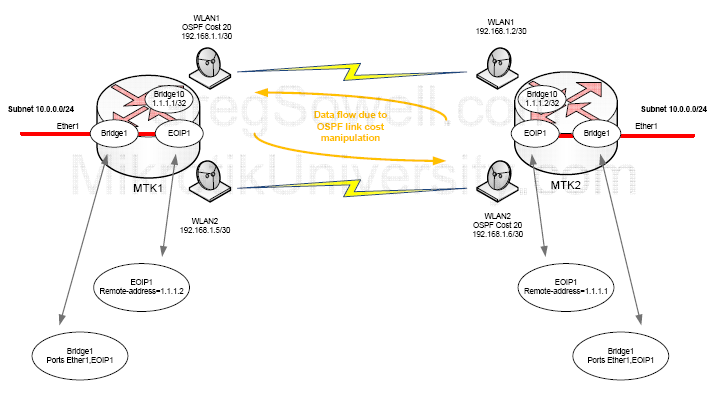Mikrotik Bridging Networks With Full Duplex Wireless Links
The other day I had a question…”How can I bridge two networks using full duplex wireless links?” Another stipulation was to also use OSPF. Here’s our diagram:

What we want to accomplish is this:
Step one is to just put the IP addresses on:
MTK1
1 2 3 4 5 | /ip address
add address=192.168.1.1/30 broadcast=192.168.1.3 comment="" disabled=no \
interface=wlan1 network=192.168.1.0
add address=192.168.1.5/30 broadcast=192.168.1.7 comment="" disabled=no \
interface=wlan1 network=192.168.1.4 |
MTK2
1 2 3 4 5 | /ip address
add address=192.168.1.2/30 broadcast=192.168.1.3 comment="" disabled=no \
interface=wlan1 network=192.168.1.0
add address=192.168.1.6/30 broadcast=192.168.1.7 comment="" disabled=no \
interface=wlan1 network=192.168.1.4 |
Now that we have IP addresses on the interface, make sure you can ping your neighbor 🙂
Now, lets go ahead and crank on OSPF(Turn on OSPF and set interface costs):
MTK1
1 2 3 4 5 | /routing ospf network add area=backbone comment="" disabled=no network=0.0.0.0/0 /routing ospf interface add cost=20 instance-id=0 interface=wlan1 network-type=broadcast passive=no |
MTK2
1 2 3 4 5 | /routing ospf network add area=backbone comment="" disabled=no network=0.0.0.0/0 /routing ospf interface add cost=20 instance-id=0 interface=wlan2 network-type=broadcast passive=no |
Now we will create our loopback interface (a bridge interface with no ports added):
MTK1-2
1 2 3 4 5 | /interface bridge
add admin-mac=00:00:00:00:00:00 ageing-time=5m arp=enabled auto-mac=yes \
comment="" disabled=no forward-delay=15s l2mtu=65535 max-message-age=20s \
mtu=1500 name=bridge10 priority=0x8000 protocol-mode=none \
transmit-hold-count=6 |
Now, throw an IP address on our loopback interface:
MTK1
1 2 3 | /ip address
add address=1.1.1.1/32 broadcast=1.1.1.1 comment="" disabled=no interface=\
bridge10 network=1.1.1.1 |
MTK2
1 2 3 | /ip address
add address=1.1.1.2/32 broadcast=1.1.1.1 comment="" disabled=no interface=\
bridge10 network=1.1.1.1 |
We are now going to add an EOIP tunnel interface. This tunnel interface will allow us to bridge traffic. The remote address will be set to that of the loopback interface. This way no matter which wireless interface the traffic enters it will always be able to reach the loopback interface!
MTK1
1 2 3 4 | /interface eoip
add arp=enabled comment="" disabled=no l2mtu=65535 mac-address=\
02:68:73:AC:10:E1 mtu=1500 name=eoip-tunnel1 remote-address=1.1.1.2 \
tunnel-id=0 |
MTK2
1 2 3 4 | /interface eoip
add arp=enabled comment="" disabled=no l2mtu=65535 mac-address=\
02:68:73:AC:10:E1 mtu=1500 name=eoip-tunnel1 remote-address=1.1.1.1 \
tunnel-id=0 |
Create a bridge interface to bridge the EOIP tunnel interface over to the ethernet interface and then add the ports to the bridge:
MTK1-2
1 2 3 4 5 6 7 8 9 10 11 12 | /interface bridge
add admin-mac=00:00:00:00:00:00 ageing-time=5m arp=enabled auto-mac=yes \
comment="" disabled=no forward-delay=15s l2mtu=1526 max-message-age=20s \
mtu=1500 name=bridge1 priority=0x8000 protocol-mode=none \
transmit-hold-count=6
/interface bridge port
add bridge=bridge1 comment="" disabled=no edge=auto external-fdb=auto \
horizon=none interface=ether1 path-cost=10 point-to-point=auto priority=\
0x80
add bridge=bridge10 comment="" disabled=no edge=auto external-fdb=auto \
horizon=none interface=eoip-tunnel1 path-cost=10 point-to-point=auto \
priority=0x80 |
So with this configuration we have a full duplex wireless link due to our OSPF cost manipulation. Since the cost is higher on certain interfaces, traffic will choose to flow in a circular pattern through the interfaces that don’t have a cost associated with them. If one of the interfaces fails, OSPF will fail the routing over to the remaining interface.
Both ether1 interfaces are on the same L2 subnet and have the advantage of higher throughput with link failover.
Alternatives
Bonding
You could bond the wireless interfaces and do L2 round robin to balance the traffic. One concern I have is that you might get some wacky jitter over the wireless links. In theory they should suffer the amount of wireless delay, though 🙂


One thing we do is have frequency diversity for some clients in this scenario. We have several of these full duplex links deployed where one radio is 5.x and the other radio is 3.65. Has proved to be useful a couple of times.
@Justin
Good call dude. How about with all the GPS sync…I assume this will alleviate some of the issues?
You could have just asked me =)
http://stfunoo.be/?p=696
@8up
Yeah, but you don’t have any pretty pictures to go along with yours 😛
Could this be done using the ethernet ports with external radios attached instead of wlans?
@Mike
It should.
Hi Greg,
Been reading all your stuff and its great!!!!and thank you for your kind heart in sharing your knowledge..
About this OSPF, if the subnet are the same on both Ether1 of the routers, I CAN’T ping any of the IP on the otherside. But if I change it with different subnet I can ping from the router(winbox) but not on the the devices Connected to the Ether1 of both routers e.g.PC1 to PC2( PC1 has similar subnet with that of ether1 left side and PC2 on the ether1 of the right side routers(both router have different subnet). Why?? OSPF can’t work in transparent bridging??
Thank you
A.J. Villarose
Hi Greg,
My bad…I got a typo on the far-end network..its working now..GREAT!!!!BLOGGGGGGGGG!!!!!
Hey greg, the example configs for the addressing of the wlan interfaces is all on wlan1. Maybe adjust those second /30’s in the example to reflect your pretty picture 😉